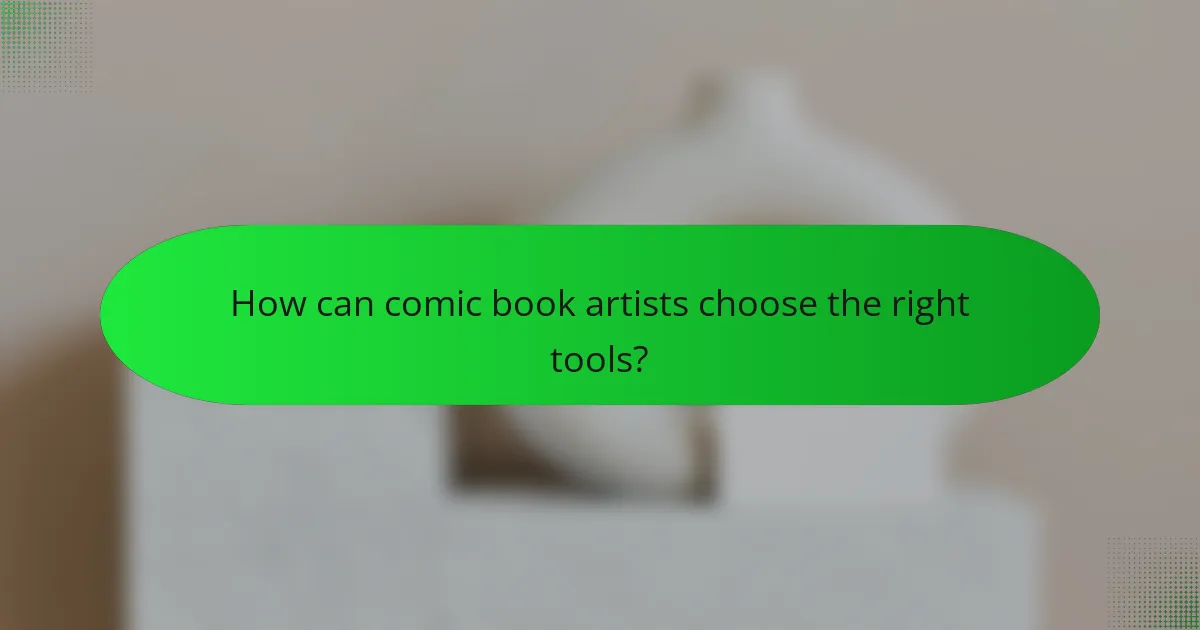The article focuses on essential tools for comic book artists, highlighting key materials, software, and techniques that enhance the creative process. It outlines traditional tools such as pencils, inks, markers, and sketchbooks, alongside digital tools like Adobe Photoshop and Clip Studio Paint. The importance of selecting the right tools based on artistic style and needs is emphasized, as well as evaluating the quality of materials for optimal results. Additionally, the article offers practical advice on maintaining a consistent practice schedule, utilizing tutorials, organizing workspaces, and seeking feedback to improve artistry and efficiency in comic creation.

What are the essential tools for comic book artists?
Essential tools for comic book artists include pencils, inks, and digital software. Pencils are used for sketching and initial layouts. Inks provide definition and contrast to the artwork. Digital software like Adobe Photoshop and Clip Studio Paint allows for coloring and editing. Markers and pens are often used for inking details. A lightbox helps in tracing and refining artwork. Rulers and T-squares assist in creating precise lines and layouts. Finally, sketchbooks are essential for brainstorming and practice.
How do materials impact the comic book creation process?
Materials significantly impact the comic book creation process. The choice of paper affects the texture and feel of the comic. Different inks influence the vibrancy and durability of illustrations. Pencils and pens determine the precision and style of the artwork. Digital tools provide flexibility and ease in editing. Each material contributes to the overall aesthetic and storytelling. For instance, high-quality paper can enhance print quality. Additionally, the use of specific inks can prevent smudging and fading. Ultimately, materials shape the final product and the artist’s creative expression.
What types of traditional materials do comic book artists use?
Comic book artists use a variety of traditional materials. Common materials include pencils, inks, and markers. Artists often use graphite pencils for initial sketches. Inking is typically done with pens or brushes. Many artists prefer India ink for its rich black color and permanence. Markers are used for coloring and shading. Watercolors and acrylics can also be utilized for more vibrant effects. Additionally, artists often use Bristol board as a drawing surface. These materials have been standard in the comic book industry for decades.
How do different paper types affect the final artwork?
Different paper types significantly affect the final artwork. The texture of the paper influences how ink or pencil adheres to its surface. For instance, smooth paper allows for fine details and crisp lines. Textured paper, on the other hand, can create a more organic, varied line quality. Weight and thickness of the paper also play a crucial role. Heavier paper can support wet media without warping, while lighter paper may buckle under heavy ink application. Additionally, the color of the paper can alter the perception of colors used in artwork. For example, warm-toned paper can enhance warm colors, while cool-toned paper may enhance cooler colors. Different finishes, such as matte or glossy, affect how light interacts with the artwork, impacting visual appeal. Each paper type thus contributes uniquely to the overall aesthetic and durability of the final piece.
What role does software play in modern comic book artistry?
Software plays a crucial role in modern comic book artistry by providing tools for digital creation and manipulation. Artists use software like Adobe Photoshop and Clip Studio Paint for drawing and coloring. These programs offer layers, brushes, and effects that enhance creativity. Additionally, software facilitates collaboration among artists and writers through cloud-based platforms. It allows for easy revisions and feedback in real-time. Digital tools also streamline the publishing process, enabling artists to export work in various formats. The use of software has transformed traditional techniques, making art more accessible and efficient.
What are the most popular software options for comic book artists?
The most popular software options for comic book artists include Clip Studio Paint, Adobe Photoshop, and Procreate. Clip Studio Paint is favored for its specialized tools for comic creation. It offers features like panel layouts and vector drawing. Adobe Photoshop is widely used for its versatile editing capabilities and extensive brush options. Procreate is popular among digital artists for its intuitive interface and portability on iPad. Other notable mentions are Corel Painter and Manga Studio, which cater to specific artistic needs. These software options are frequently recommended by professionals in the comic book industry.
How does digital software enhance the creative process?
Digital software enhances the creative process by providing versatile tools for artists. It allows for easy experimentation with colors, shapes, and layouts. Artists can quickly undo mistakes and try different approaches without wasting materials. Software like Adobe Photoshop and Clip Studio Paint offers layers, which help in organizing complex illustrations. These programs also include brushes that mimic traditional media, giving artists a familiar feel. Additionally, digital software enables collaboration through cloud-based platforms. This accessibility allows feedback and revisions to occur in real-time. Overall, digital tools streamline workflows and foster innovation in artistic expression.
What techniques are vital for comic book artists to master?
Comic book artists must master several vital techniques. These include drawing fundamentals, such as anatomy and perspective. Understanding panel layout is crucial for effective storytelling. Artists should also learn inking techniques to enhance their drawings. Color theory is important for creating mood and depth. Mastering lettering techniques ensures clarity in dialogue. Additionally, digital tools and software proficiency are essential in modern comic creation. Each of these techniques contributes significantly to the overall quality of comic art.
Which drawing techniques are essential for creating dynamic characters?
Essential drawing techniques for creating dynamic characters include gesture drawing, foreshortening, and line variation. Gesture drawing captures the essence and movement of a character quickly. This technique emphasizes posture and action, allowing artists to convey emotion and energy. Foreshortening creates the illusion of depth and perspective. This technique involves drawing objects or figures shorter than they actually are to suggest three-dimensionality. Line variation adds interest and weight to the character. By varying line thickness, artists can enhance the sense of movement and focus on certain areas. These techniques are foundational in character design and storytelling.
How can artists effectively use color in their comics?
Artists can effectively use color in their comics by understanding color theory and its emotional impact. Color theory explains how colors interact and influence perception. For instance, complementary colors create contrast and draw attention. Artists should also utilize a limited color palette to maintain cohesion. This approach enhances visual storytelling and prevents overwhelming the reader. Additionally, artists can use color to signify character emotions or themes. For example, warm colors may convey excitement, while cool colors can evoke calmness. Consistency in color use throughout the comic helps establish a recognizable style. Studies show that color can significantly affect reader engagement and interpretation, making its effective use crucial for comic artists.

How can comic book artists choose the right tools?
Comic book artists can choose the right tools by assessing their specific artistic style and needs. Identifying whether they prefer traditional or digital mediums is crucial. Traditional artists often select pens, pencils, and inks that suit their drawing style. Digital artists typically choose software that offers the features they require, such as Adobe Photoshop or Clip Studio Paint.
Evaluating the quality of materials is essential for both mediums. High-quality paper and inks prevent smudging and fading in traditional art. For digital tools, a responsive graphics tablet enhances drawing precision. Artists should also consider their budget and invest in tools that provide the best value for their work.
Experimenting with different tools can help artists discover what works best for them. Many professionals recommend trying out various brands and types before making a final decision. Ultimately, the right tools enhance the artist’s workflow and the quality of their comic book illustrations.
What factors should artists consider when selecting materials?
Artists should consider durability, texture, and compatibility when selecting materials. Durability affects the lifespan of the artwork. For example, materials like acrylic paint are known for their longevity. Texture influences the visual and tactile qualities of the piece. Different surfaces, such as canvas or paper, provide varied textures. Compatibility ensures that materials work well together. For instance, oil paints require specific solvents that may not be suitable for water-based mediums. Additionally, artists should consider the intended audience and purpose of the artwork. This can guide material choice based on the desired impact and presentation.
How does budget influence the choice of tools?
Budget significantly influences the choice of tools for comic book artists. A limited budget restricts access to high-end materials and software. Artists may opt for more affordable options that still meet their needs. This often leads to selecting basic tools that are cost-effective. For instance, traditional artists might choose lower-priced sketchbooks and pencils. Digital artists may prefer budget-friendly software with essential features. The quality of tools can impact the final artwork. However, many artists find ways to create impressive work within their budget constraints. Ultimately, budget shapes the range of tools available and influences creative decisions.
What are the pros and cons of traditional vs. digital tools?
Traditional tools offer tactile feedback and a sense of authenticity. They allow for unique textures and physical nuances in art. Many artists find traditional methods enhance creativity. However, traditional tools can be less efficient and time-consuming. They often require more space for materials and cleanup.
Digital tools provide versatility and ease of editing. They enable quick adjustments and layering without physical constraints. Digital platforms often include advanced features like undo options and customizable brushes. Yet, they may lack the organic feel of traditional media. Additionally, the learning curve for software can be steep for some artists.

What are some best practices for using these tools effectively?
To use essential tools for comic book artists effectively, maintain a consistent practice schedule. Regular use of tools enhances skill and familiarity. Invest in high-quality materials, as they often yield better results. For software, utilize tutorials to understand features and shortcuts. Organize your workspace to minimize distractions and improve workflow. Use layers in digital art to separate elements easily. Save your work frequently to prevent data loss. Lastly, seek feedback from peers to identify areas for improvement. These practices contribute to better artistry and efficiency in comic creation.
How can artists maintain their tools for longevity?
Artists can maintain their tools for longevity by implementing regular cleaning and proper storage practices. Cleaning tools after each use prevents buildup of materials that can cause damage. For brushes, rinsing with appropriate solvents preserves bristles. Storing tools in a dry, temperature-controlled environment prevents warping and rust. Using protective cases or holders can safeguard delicate items from physical damage. Regularly inspecting tools for wear allows for timely repairs or replacements. Maintaining a routine inventory of supplies ensures artists have necessary replacements on hand. Following manufacturer guidelines for specific tools enhances their lifespan.
What cleaning techniques are recommended for traditional tools?
Recommended cleaning techniques for traditional tools include using mild soap and warm water. This method effectively removes ink and paint residues. For brushes, gently swirl them in soapy water and rinse thoroughly. Avoid hot water as it can damage bristles. For metal tools, wipe with a cloth soaked in solvent to remove stubborn residues. Ensure tools are dried properly to prevent rust. Regular cleaning after each use maintains tool integrity and performance.
How can digital artists optimize their software settings?
Digital artists can optimize their software settings by adjusting preferences for performance and usability. They should start by configuring the canvas size and resolution to match their project’s needs. Higher resolution settings can improve detail but may slow performance. Artists should also customize shortcut keys for frequently used tools to enhance workflow efficiency.
Additionally, adjusting brush settings for opacity and flow can lead to more precise control over strokes. Artists can benefit from enabling GPU acceleration if supported by their hardware. This feature can significantly enhance rendering speeds and reduce lag.
Lastly, keeping software updated ensures access to the latest features and performance improvements. Regularly checking for updates can help maintain optimal functionality.
What tips can help artists improve their workflow?
Artists can improve their workflow by organizing their workspace effectively. A clutter-free environment enhances focus and efficiency. Setting specific goals for each session helps maintain direction. Utilizing digital tools can streamline processes, such as using software for sketching or coloring. Time management techniques, like the Pomodoro Technique, can increase productivity. Regular breaks prevent burnout and maintain creativity. Collaborating with other artists can provide fresh perspectives and motivation. Lastly, continuous learning through tutorials and workshops can enhance skills and techniques.
How can time management enhance the creative process?
Time management enhances the creative process by allowing artists to allocate specific periods for brainstorming, drafting, and refining their work. This structured approach minimizes distractions and fosters a focused mindset. By setting deadlines, artists can maintain momentum and avoid procrastination. Research shows that time constraints can boost creativity by forcing individuals to think more efficiently (M. Csikszentmihalyi, “Creativity: Flow and the Psychology of Discovery and Invention”). Effective time management also helps in balancing artistic endeavors with other responsibilities, ensuring consistent progress in projects. Overall, a well-organized schedule can lead to higher quality outputs and greater satisfaction in the creative journey.
What common mistakes should comic book artists avoid?
Comic book artists should avoid several common mistakes. One mistake is neglecting character consistency. Inconsistent character design can confuse readers and weaken storytelling. Another mistake is poor panel layout. A chaotic layout disrupts the flow of the narrative. Artists often overlook the importance of backgrounds. Empty or poorly drawn backgrounds can detract from the overall quality of the comic.
Additionally, artists may rush their work. Rushed artwork often results in lower quality and missed details. They sometimes fail to plan their pages. Lack of planning can lead to awkward pacing and composition. Lastly, artists may ignore feedback. Constructive criticism is essential for growth and improvement in their craft.
Essential tools for comic book artists encompass a range of materials, software, and techniques critical to the creation process. Key traditional materials include pencils, inks, markers, and various types of paper, each influencing the artwork’s final appearance. Digital software, such as Adobe Photoshop and Clip Studio Paint, plays a significant role in enhancing creativity and streamlining workflows. Artists must also master essential techniques, including drawing fundamentals, color theory, and effective panel layouts, to produce high-quality comics. Understanding how to select and maintain tools is crucial for optimizing the artistic process and achieving desired outcomes.